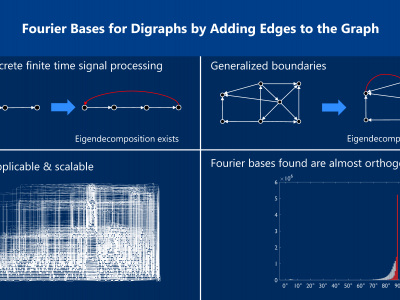Documents
Presentation Slides
Digraph Signal Processing with Generalized Boundary Conditions

- Citation Author(s):
- Submitted by:
- Bastian Seifert
- Last updated:
- 5 May 2022 - 9:30am
- Document Type:
- Presentation Slides
- Document Year:
- 2022
- Event:
- Presenters:
- Bastian Seifert
- Paper Code:
- SS-9.6
- Categories:
- Log in to post comments
Signal processing on directed graphs (digraphs) is problematic, since the graph shift, and thus associated filters, are in general not diagonalizable. Furthermore, the Fourier transform in this case is now obtained from the Jordan decomposition, which may not be computable at all for large graphs. We propose a novel and general solution for this problem based on matrix perturbation theory: We design an algorithm that adds a small number of edges to a given digraph to destroy nontrivial Jordan blocks. The obtained digraph is then diagonalizable and yields, as we show, an approximate eigenbasis and Fourier transform for the original digraph. We explain why and how this construction can be viewed as generalized form of boundary conditions, a common practice in signal processing. Our experiments with random and real world graphs show that we can scale to graphs with a few thousands nodes, and obtain Fourier transforms that are close to orthogonal while still diagonalizing an intuitive notion of convolution. Our method works with adjacency and Laplacian shift and can be used as preprocessing step to enable further processing as we show with a prototypical Wiener filter application.

